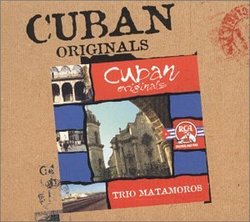| All Artists: Trio Matamoros Title: Cuban Originals Members Wishing: 0 Total Copies: 0 Label: RCA Intl Original Release Date: 2/22/2000 Release Date: 2/22/2000 Genres: International Music, Latin Music Styles: Caribbean & Cuba, Cuba Number of Discs: 1 SwapaCD Credits: 1 UPC: 743217278229 |
Search - Trio Matamoros :: Cuban Originals
 | Trio Matamoros Cuban Originals Genres: International Music, Latin Music
Few Cuban recording artists since the 1930s have left behind music as enduringly beautiful as Trio Matamoros. Beginning in the 1920s, Miguel Matamoros, Siro Rodriguez, and Rafael Cueto first envisioned the popular form of ... more » |
Larger Image |
CD Details
Synopsis
Amazon.com
Few Cuban recording artists since the 1930s have left behind music as enduringly beautiful as Trio Matamoros. Beginning in the 1920s, Miguel Matamoros, Siro Rodriguez, and Rafael Cueto first envisioned the popular form of the Cuban son by updating the older European bolero style--bearing down on the rhythm and adding melodic texture to the vocals. "El Que Siembre Su Maiz," one of the trio's early recordings, marries gentle harmonies to the shimmering pulse of a tres guitar. But the lulling mood is short-lived as call-and-response vocals take wing and soar above the intensified beat. "Alma de Roca" has glowing acoustic guitar textures that most modern musicians could only match with a bevy of electronic boxes, though this remarkable performance was pulled straight from an old 78 rpm record. In later years, the trio expanded to a larger ensemble and added legendary vocalist Beny Moré, who eventually became Pérez Prado's lead singer before starting his own orchestra. Songs from the mambo period remain incredibly inventive, from the cascading piano punctuating "Pelota" to the laughing trumpet of "Buche y Plume No Mas." Trio Matamoros recorded for almost 50 years, so here's hoping that the Cuban Originals series has more superb performances on tap. --Bob Tarte.

 Track Listings (16) - Disc #1
Track Listings (16) - Disc #1